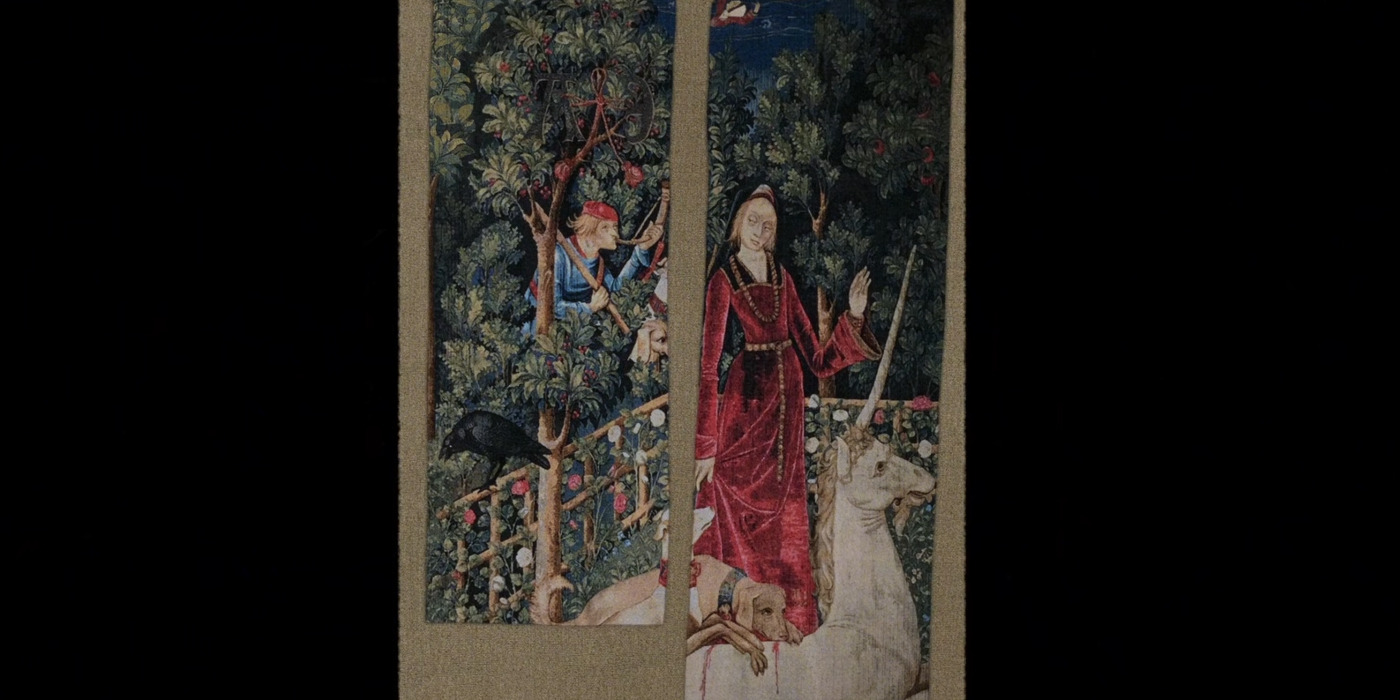The dark fantasy film ‘Death of a Unicorn’ presents an outrageous story about a fascinating mythological creature who ends up being the harbinger of great horror. On their drive out to the Leopold Wilderness Reserve, single father Elliot and his daughter, Ridley, accidentally run over a peculiar horned steed with their car. In the aftermath, Elliot’s billionaire boss discovers the healing properties of the unicorn and strives to exploit them for his own benefit. Nonetheless, once the wealthy Leopold family and subsequently promotion-seeking Elliot pursue the creature’s hidden magic, they invite the lethal ire of the majestic creatures.
Ridley, who develops a unique connection to the unicorns, discovers the creatures’ true potential for danger through the Unicorn Tapestries, a historical artifact from the Middle Ages. In telling a time-honored story about unicorns, these tapestries end up spelling out the fate that awaits Elliot and the others in the wilderness reserve. As such, with these narrative elements surrounding so much of the on-screen story, their relevance to off-screen reality naturally comes into question.
The Unicorn Tapestries are Real Artworks That Can be Found at The Cloisters
Despite the fantastical origins of ‘Death of a Unicorn,’ the film actually draws from reality in setting up the lore behind its central majestically fabled creatures. In the story, most of the context around the unicorns and their historically violent aggression against wannabe captors is gleaned through The Unicorn Tapestries. These works of art, a series of seven, exist even off-screen, known by other monikers such as Hunt of the Unicorn or La Chasse à la licorne. Believed to have originated around 1495 to 1505 from the Southern Netherlands, they’re some of the most exceptionally woven artworks from the Middle Ages. Today, they’re displayed at the Met Cloisters in Manhattan, New York.

As Ridley studies these tapestries in the story, she concludes that there is a long history of greedy humans attempting to cage and exploit unicorns. She infers that the artwork tells the story of one such instance wherein noblemen tried to capture a unicorn and ended up falling victim to its ferocious horn. Furthermore, she also makes the connection between the creatures and their fondness for “fair-hearted maidens.” While this works spectacularly within the context of the film, serving as both a warning and a forecast, the tapestries have a different conventional interpretation in real life.

The real Unicorn Tapestries are largely believed to be in connection with Jesus Christ since the creatures were often used as allegories for him in the medieval period. Consequently, the different beats of the visual narrative, the creature’s inkling toward virgin maidens, its capture, and its following resurrection all fall into the same context. However, ‘Death of a Unicorn’ sidesteps this interpretation in favor of its own, which ends up requiring one significant fictionalization. Although the on-screen story showcases the real tapestries, it adds onto the fifth piece, ‘The Unicorn Surrenders to a Maiden,’ in order to better fit the overarching fictitious narrative. Thus, some degree of fiction ultimately ends up bleeding onto the otherwise real Unicorn Tapestries.
Leopold Wilderness Reserve is the Fictional Backdrop to the Story
The Leopold Wilderness Reserve becomes the background to Elliot and Ridley’s story early on, as the father-daughter duo arrive at the estate of the former’s boss. Odell Leopold, owner of the Reserve, is an affluent billionaire who has retreated to his Ranch with his family in the later stages of his fatalistic cancer. In his final days, he’s eager to form bridges between his lucrative company and his family through Elliot, his trusted attorney. However, once the lawyer inadvertently brings a dead unicorn to his doorstep, Odell finds a brand-new motivation: immortality through ownership of the unicorns and their secrets.
As a result, the Leopold Wilderness Reserve, an otherwise protected area for wildlife, becomes a hunting ground for unicorns. The irony of the situation adds to the story’s dark humor, underlining the thematic commentary about the facetious and gluttonous nature of the rich and powerful. For the same reason, the Reserve mostly serves a crucial narrative purpose, both in the progression of the plot and the characterization of the Leopold family. However, beyond the screen, the Reserve, much like its owners, has no direct basis in reality.
Read More: Is Death of a Unicorn on Netflix, Max, Hulu, or Prime? Where to Watch the Movie Online?


